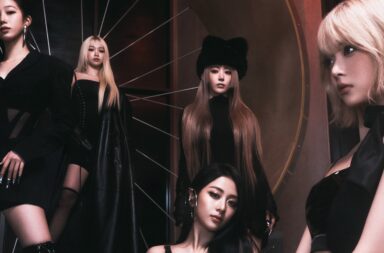While the landscape of Korean entertainment can be vast and wondrous, it’s often the little things that make us fall in love, inspire awe, evoke secondhand embarrassment, or sometimes… break our hearts.
In this edition of Beats of the Month, we ask our writers: Among the many things vying for your attention this month, what won and made your heart beat?
Welcome Back B.A.P. (Bang & Jung & Yoo & Moon)
— Eileen
While the fourth (or fifth?) generation of K-pop continues to thrive, we’ve also seen more second/third generation idols reunite in the past couple of years with releases from acts like Girls’ Generation, Kara, and Infinite to name a few. As a fan who grew up listening to these older groups, these long-awaited comebacks never fail to put me in a good mood.
Above all though, the reunion I anticipated the most was B.A.P. They were once my absolute favorite group right up until their disbandment, and news of their comeback felt like a fantasy at the time. Now, as a quartet (with Zelo unable to join because of his military service), the members have returned as Bang & Jung & Yoo & Moon.
I’m still a bit sad that they couldn’t promote under the name B.A.P officially due to TS Entertainment rising from the dead and spiting the members with the trademark rights, but every other aspect of the release has been completely dyed with B.A.P’s colors. From their Matoki characters, the alien storyline, and even the physical album versions being labeled as “Best,” “Absolute,” and “Perfect,” Curtain Call feels tailor-made for long-term fans and the members themselves. And title track “Gone” accumulates all these nostalgic and regretful emotions in a simple yet weighted tune with lyrics reflecting on their bittersweet past. A wave of memories filled with happiness and heartbreak came rushing back as I listened to the track and watched the music video. After so many years of pent-up feelings, this touching goodbye song has finally given fans closure.
Hopefully, this will be the start of a new era for B.A.P with a future even more radiant than their youth.
Le Sserafim and Solar Do Ballroom-Homage/Allyship Right
— Sabrina
After watching Le Sserafim’s latest MV “Crazy”, I was struck by seeing House of Juicy Couture in the credits for dancing and creative direction. Some may recognize the group as the winners of the competitive reality show Legendary, which profiled ballroom culture. Le Sserafim have often taken inspiration from international music genres and dance styles, like Afrobeats and amapiano in “Smart”. At their best, they co-create music with people of the culture, as with reggaeton singer Isabella Lovestory in “Antifragile”. By bringing in the House of Juicy Couture for “Crazy”, Le Sserafim honor people of the queer Black subculture that originated voguing and the ballroom scene. K-pop deservedly receives criticism at times for appropriating from other cultures, so this type of representation gives credit that is sorely needed.
This also gives me an opportunity to talk about another recent video featuring a ballroom house: the performance video for Solar’s “Colors,” released in May. If “Crazy” is an homage, “Colors” feels like an act of allyship, highlighting the House of Love, South Korea’s largest kiki house. House mother Love Ran has choreographed this dance, as well for artists such as Chungha, Weki Meki, and Kwon Eunbi, and she performs as well (the dancer in the blue bob). The “Colors” MV, however, not only includes the House of Love in front of and behind the camera, but puts individual dancers in a literal spotlight. In the final scene of the video, Solar wears pink and the dancers are dressed in many other bright colors. All together, they make up the colorful community Solar wants to embrace. She also took this visual approach to her performance on Show Champion and also brought dancers on The Show, platforming members of the House of Love on Korean television.
“Crazy” and “Colors” represent somewhat different, but meaningful ways of integrating ballroom culture into K-pop. They show how K-pop can celebrate respect and celebrate the contributions of marginalized communities who are the source of inspiration for much of pop culture.
Revisiting the Devil Judge (+ the Power of Soundtrack and Credit Design)
— Siena
I’m currently re-watching the 2021 dystopian thriller drama The Devil Judge, a wickedly entertaining if occasionally uneven show (as our writer Renee captured perfectly in her Seoulbeats review). Something that I noticed is that, unlike with so many other shows, I never skip over The Devil Judge‘s opening credits. If anything, I look forward to it each episode. It’s a rare thing to see such a well-crafted title sequence, and one that represents its show so well with its moody lighting, emphasis on character, and propulsive music. Indeed, the entire soundtrack to The Devil Judge, a dramatic mix of electronic and orchestral sounds, is worth shouting out, for while many dramas produce fun OST tracks, it’s far more rare to see incidental music at this level (the other drama that comes to mind for me is Extraordinary You).
While skipping the opening credits is a time-honored tradition, The Devil Judge reminded me that when done right, a title sequence can be a fantastic bridge to get the viewer in the perfect mindset for the episode to come, and it made me wish more dramas would take advantage of that opportunity. And despite its bombastic tendencies, The Devil Judge as a whole is a strong example of how a good drama can be made great when its creators pay attention to all the supporting details (music, supporting characters and arcs, styling).
(YouTube [1][2][3][4][5][6]. Images via HYBE, Source Music.)



